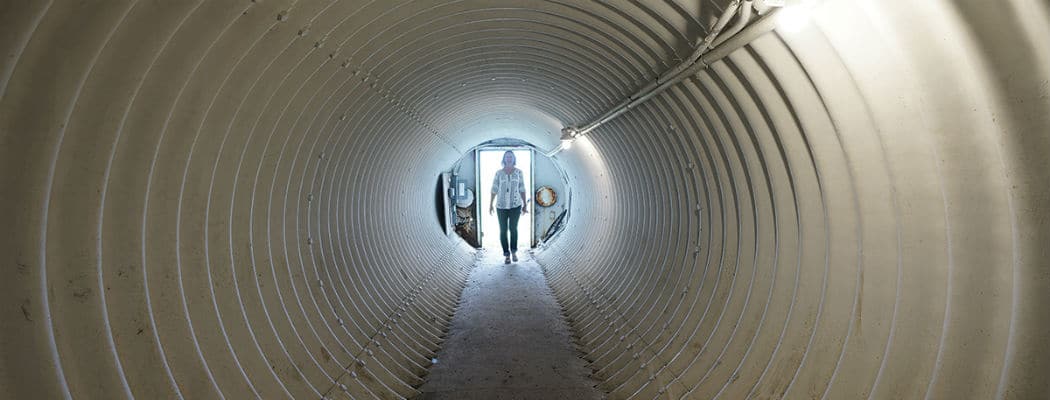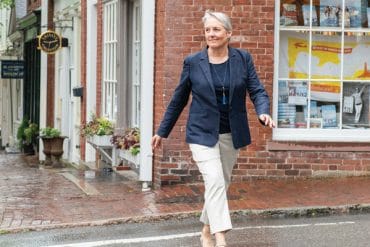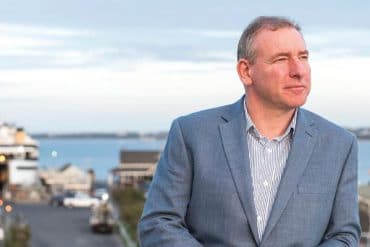Could the JFK Bunker in Tom Nevers become Nantucket’s next museum?
In the middle of a windswept field at Tom Nevers’ southernmost edge, a semicircular, rust-streaked portal emerges from a grassy hillock like the hatch of a landlocked submarine or a steampunk hobbit hole. Locals know it simply as the bunker. Five decades ago, this makeshift structure embodied the doomsday fears of a nation in the grip of the Cold War.
 Shortly before President John F. Kennedy took office in 1961, the Soviets announced they had long-range missiles capable of carrying nuclear warheads anywhere in the world. The following year, Navy Seabees on Nantucket cobbled together a subterranean structure from sections of Quonset huts. If the Russians acted on their threat to launch a first-strike missile attack against the US, Kennedy and his family would be secreted from Hyannis Port to the Nantucket bunker.
Shortly before President John F. Kennedy took office in 1961, the Soviets announced they had long-range missiles capable of carrying nuclear warheads anywhere in the world. The following year, Navy Seabees on Nantucket cobbled together a subterranean structure from sections of Quonset huts. If the Russians acted on their threat to launch a first-strike missile attack against the US, Kennedy and his family would be secreted from Hyannis Port to the Nantucket bunker.
Now, nearly thirty years since the fall of the Berlin Wall, the JFK bunker is reemerging as a possible portal to this Cold War history. Spearheading the effort is Cheryl Emery, chair of the town’s Parks and Recreation Commission. Emery hopes that if restored to its original look and feel, the bunker could recreate a critical moment in history and help revitalize a neglected corner of the island.
Recently, Emery and Mark Voigt, facilities manager for the Department of Public Works, pried open the bunker’s rusty door for visitors, revealing a tubular corrugated steel tunnel. It smells musty; the air is cool and damp. Moving through the tunnel is like walking along the undulating entrance to a funhouse. The interior is a huge half-cylinder, a larger version of the entryway. A metal ladder in a dank alcove leads to an escape hatch.
The bunker was never used as a presidential fallout shelter. It’s been a storage facility for the county fair and a clubhouse for deer hunters, who installed a bar inside. Outside the bunker, kids climbed on top of its scrub-covered hump to watch the demolition derbies once held in late summer. “This has always been the thing that’s here, and everyone does stuff around it,” Voigt says. “If you’re lucky, and you’re here when we open it up to take stuff out for the fair, you get to go inside.”
 In the 1950s, Tom Nevers Field was the site of a thirty-acre naval facility, one of several along the eastern seaboard charting offshore conditions to help detect enemy submarines. Today the field is largely underused. Surrounding the bunker are grassy fields, baseball and softball diamonds, a rock inscribed “Nantucket Island Fairgrounds,” a graffiti-covered former gatehouse, a rusting playground and an unused roller hockey rink. Remains of houses that succumbed to beach erosion are buried along the shore.
In the 1950s, Tom Nevers Field was the site of a thirty-acre naval facility, one of several along the eastern seaboard charting offshore conditions to help detect enemy submarines. Today the field is largely underused. Surrounding the bunker are grassy fields, baseball and softball diamonds, a rock inscribed “Nantucket Island Fairgrounds,” a graffiti-covered former gatehouse, a rusting playground and an unused roller hockey rink. Remains of houses that succumbed to beach erosion are buried along the shore.
Now, Emery, on the board of a recently formed citizen’s group hoping to bolster Nantucket’s recreational open spaces, is pressing for a new lease on life for Tom Nevers Field. She gestures at the wide-open expanse, water twinkling just over the bluff. “Why not bring it back? We’ve got twenty-two acres overlooking the Atlantic Ocean,” she says. “This park could be just so fantastic.” Fixing up the bunker, she says, is a logical first step. Later that day, as archivist Marie Henke digs out articles on the bunker’s history at the Nantucket Historical Association research library, she says, “Anything to do with the Kennedys is going to be a draw.”
 Last year, Emery learned of the existence of a sister bunker on a manmade island close to the Kennedys’ oceanfront winter home on millionaire’s row in Palm Beach. She called the Palm Beach Maritime Museum. Anthony Miller answered the phone. Miller, a British ex-pat and former naval architect, is passionate about all things seaworthy, historical and related to the Kennedys. He describes himself as owner of a “management company that manages a lot of nonprofits, a lot of problem businesses.” He says he opened Australia’s first five-star resort and claims ties to Ethel and Bobby Kennedy’s son, Robert F. Kennedy Jr.
Last year, Emery learned of the existence of a sister bunker on a manmade island close to the Kennedys’ oceanfront winter home on millionaire’s row in Palm Beach. She called the Palm Beach Maritime Museum. Anthony Miller answered the phone. Miller, a British ex-pat and former naval architect, is passionate about all things seaworthy, historical and related to the Kennedys. He describes himself as owner of a “management company that manages a lot of nonprofits, a lot of problem businesses.” He says he opened Australia’s first five-star resort and claims ties to Ethel and Bobby Kennedy’s son, Robert F. Kennedy Jr.
In the 1990s, Miller established the Palm Beach Maritime Museum, which included the bunker on nearby Peanut Island. The museum provided 40-minute guided tours. “We take people through the bunker, tell them the history,” he says. “We had all the artifacts. It was a fun venture.” Guests could board the Kennedy family’s ninety-two-foot yacht, the Honey Fitz, sail to dinner on Peanut Island and peruse the bunker. In 2012, Miller picked up Ethel Kennedy, Bobby Jr. and more than a dozen members of the extended family in his private boat at the tony Sailfish Club on Palm Beach and ferried them to Peanut Island. The excursion became an annual event. “They’d go through the little museum,” he says. “They love what we’re doing.”
The bunker closed in October 2017 when Miller lost an ugly, years-long battle with Palm Beach County over the six acres on Peanut Island that houses the bunker, a boathouse and dock, and a Coast Guard station museum. The county claimed the bunker had fallen into disrepair and violated safety codes. Miller says the county reneged on an agreement that would have allowed him to build a restaurant and hold 30 weddings a year on the island to generate income for the upkeep of the museum and bunker. “The county’s going to take it all over, and they’re going to do what we tried to do,” Miller says. “The [Palm Beach Maritime] Museum’s agreed to walk away from that property, and, unfortunately, we lose the bunker in that deal.”
Miller says he’s long had an eye on the Nantucket bunker. After hearing from Emery, Miller traveled to Nantucket in March. He drove out to Tom Nevers with members of the town’s licensing division, fire department and town manager’s office. The bunker has electricity, but no plumbing and no ventilation. Renovating it could be costly, but Miller seems undeterred. “I love projects, so anytime a project comes across my desk, if it’s something that looks like it’s interesting, not necessarily about the money but something fun, I take it on.” About the bunker, he says, “I’ve offered to bring it back to where it was. Everyone seems keen about the project.”
 With Emery’s support, Miller hopes the town will agree to allow Miller’s management company, Maritime Business, to renovate the bunker in exchange for a multi-year lease for public tours and collaborations with schools. He would furnish it with 1950s-era bunk beds, vintage communications devices, Geiger counters, portable bathrooms, K-rations and other actual artifacts from both the Nantucket and Palm Beach bunkers that were decommissioned after Kennedy’s death. Miller is confident he can make the bunker worth the trek to Tom Nevers. How would he do that? “Well, that’s the magic,” he laughs. “I couldn’t give you all my secrets. You got to look at it long enough to be able to figure out what would make it interesting, because there’s lots of history where a lot of people go, ‘So what.’ It has to be developed into something worth seeing.”
With Emery’s support, Miller hopes the town will agree to allow Miller’s management company, Maritime Business, to renovate the bunker in exchange for a multi-year lease for public tours and collaborations with schools. He would furnish it with 1950s-era bunk beds, vintage communications devices, Geiger counters, portable bathrooms, K-rations and other actual artifacts from both the Nantucket and Palm Beach bunkers that were decommissioned after Kennedy’s death. Miller is confident he can make the bunker worth the trek to Tom Nevers. How would he do that? “Well, that’s the magic,” he laughs. “I couldn’t give you all my secrets. You got to look at it long enough to be able to figure out what would make it interesting, because there’s lots of history where a lot of people go, ‘So what.’ It has to be developed into something worth seeing.”
Jason Bridges, chair of the Select Board, is enthusiastic about the potential benefits a revitalized bunker could bring to Tom Nevers — he lives there himself — and the island as a whole. He especially likes the fact that the bunker’s claim to fame is relatively recent. “We do a great job preserving the 19th and 18th centuries,” he says. “I’d like to see more done about 20th century preservation.” And he thinks Miller’s offer is enticing. Bridges would hate to lose out on it.
 At the same time, the town recently committed $100,000 to develop a master plan for all the island’s parks and recreational spaces, which many feel are sorely neglected. Bridges hopes to see the master plan on his desk by the end of the year. Bridges calls Tom Nevers Field “one of their most beautiful, underused parks on the island.” But the bunker will likely be one piece of a major overhaul. “We need to look at the entire project — erosion, bathrooms, etc.,” he says. “We have to do our due diligence and be really sure we’re doing this right.” The future of the bunker could be in limbo for a year or more.
At the same time, the town recently committed $100,000 to develop a master plan for all the island’s parks and recreational spaces, which many feel are sorely neglected. Bridges hopes to see the master plan on his desk by the end of the year. Bridges calls Tom Nevers Field “one of their most beautiful, underused parks on the island.” But the bunker will likely be one piece of a major overhaul. “We need to look at the entire project — erosion, bathrooms, etc.,” he says. “We have to do our due diligence and be really sure we’re doing this right.” The future of the bunker could be in limbo for a year or more.
Like many growing up in the 1950s and 1960s, Emery and Voigt recall duck-and-cover drills, films of mushroom clouds and fallout shelters tagged with signs depicting three yellow triangles inside a black circle. Soon after he was elected, President Kennedy advised American families to build bomb shelters in their back yards. Within a year, the Nantucket and Palm Beach bunkers were built, and Soviet missile sites were discovered on Cuba, only ninety miles from the US mainland. “The kids don’t know that bit of our country’s history,” Emery says. “We have to preserve our past.”







